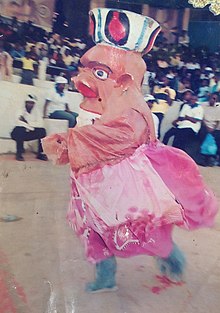
The performing arts are arts such as music, dance, and drama which are performed for an audience. They are different from the visual arts, which involve the use of paint, canvas or various materials to create physical or static art objects. Performing arts include a range of disciplines which are performed in front of a live audience, including theatre, music, and dance.

The following outline is provided as an overview of and topical guide to theatre:

A mask is an object normally worn on the face, typically for protection, disguise, performance, or entertainment, and often employed for rituals and rites. Masks have been used since antiquity for both ceremonial and practical purposes, as well as in the performing arts and for entertainment. They are usually worn on the face, although they may also be positioned for effect elsewhere on the wearer's body.

Egungun, in the broadest sense is any Yoruba masquerade or masked, costumed figure. More specifically, it is a Yoruba masquerade for ancestor reverence, or the ancestors themselves as a collective force. Eégún is the reduced form of the word egúngún and has the same meaning. There is a misconception that Egun or Eegun is the singular form, or that it represents the ancestors while egúngún is the masquerade or the plural form. This misconception is common in the Americas by Orisa devotees that do not speak Yorùbá language as a vernacular. Egungun is a visible manifestation of the spirits of departed ancestors who periodically revisit the human community for remembrance, celebration, and blessings.

Wayang, also known as wajang, is a traditional form of puppet theatre play originating from the Indonesian island of Java. Wayang refers to the entire dramatic show. Sometimes the leather puppet itself is referred to as wayang. Performances of wayang puppet theatre are accompanied by a gamelan orchestra in Java, and by gender wayang in Bali. The dramatic stories depict mythologies, such as episodes from the Hindu epics the Ramayana and the Mahabharata, as well as local adaptations of cultural legends. Traditionally, a wayang is played out in a ritualized midnight-to-dawn show by a dalang, an artist and spiritual leader; people watch the show from both sides of the screen.

Shadow play, also known as shadow puppetry, is an ancient form of storytelling and entertainment which uses flat articulated cut-out figures which are held between a source of light and a translucent screen or scrim. The cut-out shapes of the puppets sometimes include translucent color or other types of detailing. Various effects can be achieved by moving both the puppets and the light source. A talented puppeteer can make the figures appear to walk, dance, fight, nod and laugh.

Benue State is one of the North Central states in Nigeria with a population of about 4,253,641 in 2006 census. The state was created in 1976 among the seven states created at that time. The state derives its name from the Benue River which is the second largest river in Nigeria after the River Niger. The state borders Nasarawa State to the North; Taraba State to the East; Kogi State to the West; Enugu State to the South-West; Ebonyi and Cross-Rivers State to the South; and has an international border with Cameroon to the South-East. It is inhabited predominantly by the Tiv, Idoma, and Igede. Minority ethnic groups in Benue are Etulo, Igbo, Jukun peoples etc. Its capital is Makurdi. Benue is a rich agricultural region; popularly grown crops include: oranges, mangoes, sweet potatoes, cassava, soya bean, guinea corn, flax, yams, sesame, rice, groundnuts, and Palm tree.

Tiv are a Tivoid ethnic group. They constitute approximately 2.4% of Nigeria's total population, and number over 5 million individuals throughout Nigeria and Cameroon. The Tiv language is spoken by over 5 million people in Nigeria with a few speakers in Cameroon. Most of the language's Nigerian speakers are found in Benue, Taraba, Nasarawa, Plateau, Cross rivers, Adamawa, Kaduna, and the Federal Capital Territory Abuja. The language is a branch of Benue–Congo and ultimately of the Niger–Congo phylum. In pre-colonial times, the Fulani ethnic group referred to the Tiv. They depend on agricultural produce for commerce and sustenance.

Topeng is a dramatic form of Indonesian dance in which one or more mask-wearing ornately costumed performers interpret traditional narratives concerning fabled kings, heroes, and myths, accompanied by gamelan or other traditional music instruments. Topeng dance is a typical Indonesian dance that can be found in various regions of Indonesia. Topeng dance has the main characteristic that the dancers use masks to cover their faces. The dance will usually be performed by one dancer or a group of dancers.

Traditional Japanese theatre is among the oldest theatre traditions in the world. Traditional theatre includes Noh, a spiritual drama, and its comic accompaniment kyōgen; kabuki, a dance and music theatrical tradition; bunraku, puppetry; and yose, a spoken drama.

Mmanwu is a traditional masquerade of the Igbo people of Southeastern Nigeria. They are performed only by males in exclusive secret societies and involve the use of elaborate, colorful costumes that are meant to invoke ancestral spirits. Masquerade traditions have a varied range of purposes that span from performing elements of epic drama derived from community cosmology and lore, ushering in new months and seasons, honoring totems and ancestral spirits, enactments of parables or myths, with entertainment and community building serving as a consistent commonality. In the past masquerades also bore judicial, social regulatory, and even policing powers, however though these functions have decreased in modern times.
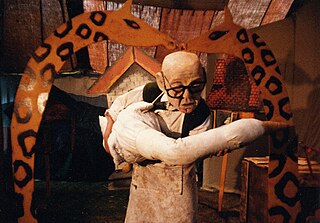
Horse and Bamboo Theatre or Horse + Bamboo Theatre is a British theatre company founded in 1978 by Bob Frith. The company was known for its use of distinctive masks and visual, puppet, physical, music-based forms rather than text. Until 2018 it worked internationally as well as from its base, then known as The Boo, in Waterfoot, Rossendale, Lancashire, UK. Since 2012 the emphasis of its work has been increasingly in serving its local community, with the last touring shows taking place in 2019. In 2022 the venue was ‘de-branded’ to ‘Horse and Bamboo’.

Karnataka has a variety of traditional arts, including folk dance and puppetry.
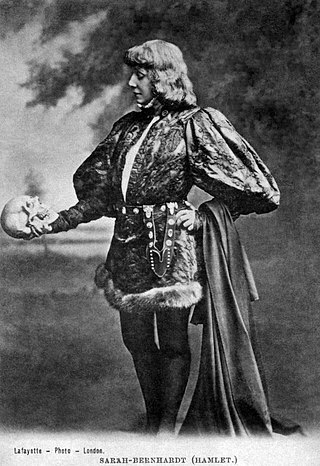
Theatre or theater is a collaborative form of performing art that uses live performers, usually actors or actresses, to present the experience of a real or imagined event before a live audience in a specific place, often a stage. The performers may communicate this experience to the audience through combinations of gesture, speech, song, music, and dance. It is the oldest form of drama, though live theatre has now been joined by modern recorded forms. Elements of art, such as painted scenery and stagecraft such as lighting are used to enhance the physicality, presence and immediacy of the experience. Places, normally buildings, where performances regularly take place are also called "theatres", as derived from the Ancient Greek θέατρον, itself from θεάομαι.
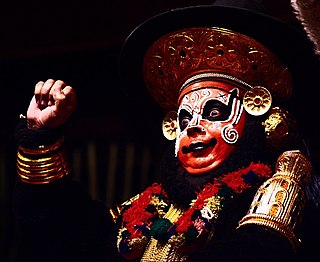
The history of theatre charts the development of theatre over the past 2,500 years. While performative elements are present in every society, it is customary to acknowledge a distinction between theatre as an art form and entertainment, and theatrical or performative elements in other activities. The history of theatre is primarily concerned with the origin and subsequent development of the theatre as an autonomous activity. Since classical Athens in the 5th century BC, vibrant traditions of theatre have flourished in cultures across the world.
Konshisha is a local government area of Benue State, Nigeria. Its headquarters are in the town of Tse-Agberagba.
James Ortese Iorzua Ayatse, Tor Tiv V from Kwande Local Government Area of Benue State in central Nigeria is a Nigerian academic who is the Paramount Ruler/King of Tiv Nation and president, Tiv Area Traditional Council and chairman, Benue State council of Chiefs. He previously served as the vice chancellor of the University of Agriculture, Makurdi and the pioneer vice chancellor of the Federal University, Dutsin-Ma respectively before succeeding Alfred Akawe Torkula, Tor Tiv IV, who ruled from 1991 until his death on 22 November 2015.

Iyorwuese Harry Hagher, is a Nigerian professor of theatre for development, playwright, poet, politician administrator and activist for social justice. He was a senator, cabinet minister, envoy and pro-chancellor of Afe Babalola University. He is renowned for his groundbreaking research on Kwagh-Hir theatre, which was inscribed on the UNESCO Intangible Cultural Heritage Lists in 2019. Hagher is passionate about the issue of leadership. His plays are preoccupied with the search for true leadership and other solutions to Africa's socio-political problems. He is known to have engaged cultural diplomacy as a tool for foreign relations while serving as Nigeria's Ambassador to Mexico, and later High Commissioner to Canada. In 2019, he was a presidential aspirant, under the platform of the Social Democratic Party (SDP). He is currently the president, African Leadership Institute, Dayton, Ohio, United States.
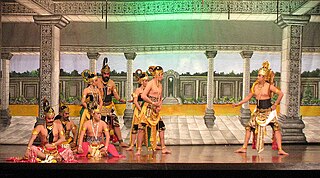
Indonesian theatre is a type of art in the form of drama performances that are staged on a stage, with a distinct Indonesian nuance or background. In general, theatre is an art that emphasizes the performing arts that are displayed in front of a large crowd. In other words, theater is a form of visualisation of a drama that is staged on the stage and watched by the audience. Indonesian theatre includes the performing arts of traditional theater and modern theatre located in the territory of Indonesia. Some examples of Indonesian theater are Arja, Wayang, Wayang wong, Lenong, Ludruk, Janger, Randai and others. Theatre in Indonesia can also be referred to as regional or ethnic theatre, because it originates and develops from 1,300 ethnic cultures in Indonesia.


